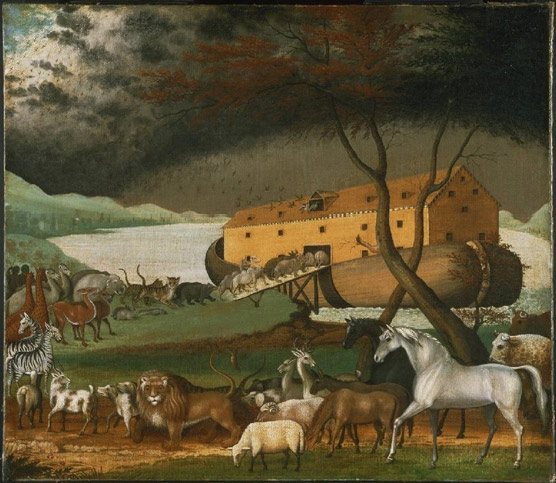The narrative of Noah’s Ark occupies a venerable space in both religious texts and popular culture. The mythos surrounding the Deluge transcends the specific traditions of any single religion, embodying a universal symbolism that reflects humanity’s collective psyche and its yearning for renewal. This article delves into the Bahá’í perspective on Deluge myths, specifically focusing on Noah’s Ark, and elucidates the philosophical implications that resonate with contemporary spiritual seekers. The underlying themes of destruction, renewal, and covenant offer profound insights pertinent to the evolution of religious thought.
The story of Noah’s Ark is not merely an account of a cataclysmic event but a multifaceted allegory of spiritual rebirth. In the Bahá’í Faith, the Deluge signifies not only a physical cleansing but also a spiritual purification. A common observation amongst religious historians is that flood myths exist across myriad cultures, including the Epic of Gilgamesh in Mesopotamian literature, the Hindu tale of Manu, and the biblical account of Noah. This convergence indicates a shared narrative impulse—a cultural archetype rooted in the human experience of transition, crisis, and renewal.
The essence of humanity’s fascination with the Deluge myth can be attributed to our intrinsic awareness of the cycles of existence. Throughout history, civilizations have faced existential threats, whether natural disasters, societal upheavals, or moral decline. Flood stories serve as metaphors for those crises, highlighting the precarious balance between order and chaos. In the Bahá’í worldview, this oscillation between destruction and renewal is mirrored in the cyclical nature of religious revelation. Every major world religion heralds a transformative figure who emerges in response to the moral exigencies of their time, making the renewal of religion an ongoing process rather than a static phenomenon.
Moreover, the iconography of Noah’s Ark serves as a powerful symbol of divine mercy and protection. The Ark itself is often interpreted as a salvific vessel—an embodiment of God’s promise to humanity, delivering those who are faithful from the torrents of change. This aligns with the Bahá’í understanding of God’s covenant with humanity, wherein each manifestation of God establishes a new covenant appropriate for the era it addresses. The flood waters that scour the earth can be seen as the trials and tribulations that prepare the spiritual ground for a renewed relationship between humanity and the Divine.
Delving further into the narrative, we encounter the character of Noah, often depicted as a paragon of righteousness amidst a corrupt society. His mission is not merely about preserving physical life; rather, it underscores the ethical imperative of upholding justice and moral integrity. In the Bahá’í context, Noah can be viewed as an archetype of the ideal teacher—one who bears the weight of moral authority while guiding his followers towards spiritual awakening. Such figures exemplify the potential within each individual to ascend to a higher moral ground, emphasizing that the responsibility for transcendence lies within the collective psyche of humankind.
The aftermath of the flood also prompts significant reflection. After the deluge, the world is described as being forged anew. This notion of a cleansed earth serves as a metaphor for the regeneration of spiritual values and ethical frameworks. The Bahá’í teachings advocate the formulation of a global civilization characterized by unity, justice, and the eradication of prejudices. The Ark can thus be interpreted as emblematic of the Bahá’í communal approach to spirituality—every person is welcomed into the vessel of faith, which serves to foster collective salvation.
Interestingly, the aftermath of the Deluge resonates with the theme of continuity and the human spirit’s indomitable nature. The survivors who disembark from the Ark are tasked with the act of reconstruction; they must cultivate the land and restore the balance disrupted by the flood. This aspect mirrors the Bahá’í belief in the power of individual and collective agency in shaping a just and harmonious world. The narrative transcends its ancient roots, becoming a call to action for modern believers to engage in the continuous renewal of their spiritual lives and social institutions.
In exploring the interplay between destruction and emergence, it becomes evident that the Deluge mythos resonates with a broader existential reality that informs the human condition. It invites reflection on humanity’s moral compass in the face of societal crises, compelling individuals towards introspective examination and collective responsibility. In a world often saturated with discord, the symbol of the Ark serves as an enduring reminder of the potential for rebirth amidst adversity.
Lastly, the ongoing relevance of the Noah story within the Bahá’í framework addresses the necessity for an evolving understanding of religious truth. Just as the Ark weathered the storm, the principles of the Bahá’í Faith provide a resilient structure capable of safeguarding humanity during turbulent times. The flood waters may recede, but the imperative for renewal and unity remains ever-present. Consequently, the narrative of Noah’s Ark transcends mere myth; it illuminates a pathway towards spiritual enlightenment and communal harmony, urging us all to navigate our own deluges with fortitude and faith.
